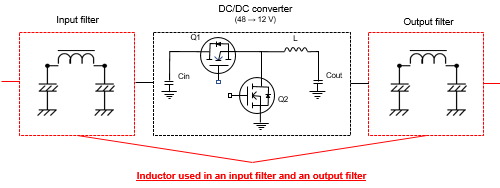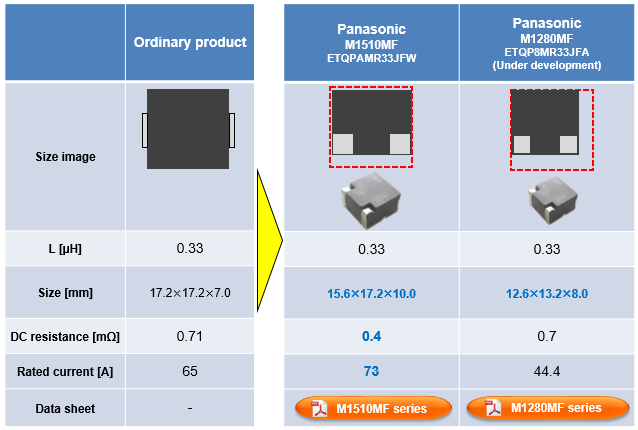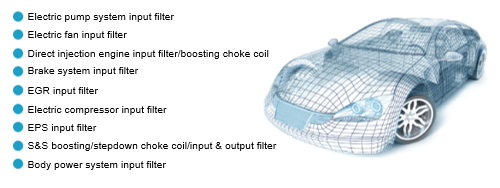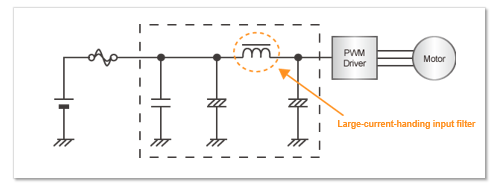Introduction of Inductor for 48-V DC/DC Converter
2022-07-22
As environment-friendly vehicles, such as 48-V mild hybrid vehicles, meet the demand for better mileage and conform to environmental regulations, the computerization of in-vehicle equipment has progressed rapidly, resulting in a significant increase in the number and scale of EUCs incorporated in vehicles. In addition, designing ECUs built into engines or integrated with mechanical elements is also in progress, leading to the demand that ECUs serve properly under severe operation conditions where the ECUs are exposed to vibrations, high temperatures, and large currents. Today, in order to remove noise from a power circuit making up an in-vehicle ECU and provide the ECU with smooth power, it is essential to equip the ECU with electronic components that show high resistance to vibrations and heat and are capable of handling large currents.
Handling of requirements for in-vehicle equipment
Large-sized product for handling large current(power inductor for handling large current)
The 48-V mild hybrid vehicle includes a DC/DC converter and inductors capable of handling large currents that serve as input/output filters. Usually, these inductors are of a toroidal coil type, ferrite coil type, or bar coil type. In this article, we would like to introduce the case where a conventional inductor (ferrite coil type), which is usually used in input/output filters, is replaced with a surface-mount type in-vehicle power inductor M15A0MF series or M1280MF series.


Replacing a 20 mm x 20 mm square inductor, which is the conventional product of the toroidal coil type or ferrite coil type, with the Panasonic power inductor M15A0MF series or M1280MF series achieves component miniaturization, allowing space-saving for the mounting area. Being a surface-mounting type, the Panasonic power inductor does not require potting and can be mounted without a bonding process, which reduces man-hours. Furthermore, while conventional products are resistant to vibrations of about a 5G scale, the Panasonic power inductor guarantees its resistance to vibrations to a 30G scale, offering greater product reliability. Panasonic products introduced in this article have their own unique individual features. The M15A0MF series offers advantages over ordinary products in applications where a rated current is equal to or higher than that of an ordinary product and a lower DC resistance is required. It allows product miniaturization that cannot be achieved by conventional products. The M1280MF series., on the other hand, offers advantages over conventional products in applications where space-saving in a mounting area is required, allowing over 40% in reduction of the mounting area that cannot be achieved by conventional products. If a circuit in use has a problem with insufficient current capacity, connecting these products in parallel in conformity with the necessary specifications solves the problem.
Table 1 Comparison of specifications of products handling large currents

Vibration resistance performance (highly vibration-resistant power inductors)
In the trend toward environment-friendly product development, direct mounting of ECUs on engines and integrating mechanical elements and electronic elements are progressing from the viewpoint of unit downsizing. As a result, electronic components making up the ECU are required to serve properly under severer operation conditions where the ECU is exposed to vibrations and high temperatures. To meet this requirement, Panasonic offers a lineup of highly vibration-resistant power inductors capable of withstanding vibrations of a 50G scale or higher.


A conventional product has a self-resonant frequency of around 2000 Hz, which is so low it can cause a problem with its resistance to vibrations. By adopting a metal composite material including an original metal magnetic material and applying original winding and molding technologies, Panasonic has achieved a coil that has an enhanced self-resonant frequency of 3000 Hz or higher and vibration resistance to vibrations of a 50G scale or higher. A conventional product needs to be fixed by a bonding agent in order to ensure its vibration resistance performance. In the case of the new product, however, the height of a lead terminal position is reduced to 1/2 of that of our conventional product so that the lead terminal is located closer to the mounting board, which achieves improved vibration resistance. Furthermore, in-vehicle ECUs are required not only to have high vibration resistance but also to be heat resistant and able to handle large currents at the same time. There has been still the unsolved problem, that because of its low height and small size, a coil capable of withstanding vibrations of a 30G scale or higher cannot handle a large current. Panasonic's product, however, offers high heat resistance and the ability to handle a large current as well while achieving resistance to vibrations of a 50G scale or higher.


Conclusion
We expect that enhanced vehicular functions, including vehicle electrification, will lead to an increase in the number of ECUs and current values flowing through electric circuits incorporated into vehicles. To cope with this future trend, Panasonic will endeavor to improve the reliability of its products by offering highly reliable power inductors and also make efforts to reduce environmental loads through space-saving EUC boards and man-hour reduction.
